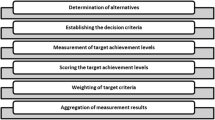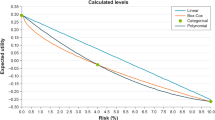Abstract
A standard practice in health economic evaluation is to monetize health effects by assuming a certain societal willingness-to-pay per unit of health gain. Although the resulting net monetary benefit (NMB) is easy to compute, the use of a single willingness-to-pay threshold assumes expressibility of the health effects on a single non-monetary scale. To relax this assumption, this article proves that the NMB framework is a special case of the more general stochastic multi-criteria acceptability analysis (SMAA) method. Specifically, as SMAA does not restrict the number of criteria to two and also does not require the marginal rates of substitution to be constant, there are problem instances for which the use of this more general method may result in a better understanding of the trade-offs underlying the reimbursement decision-making problem. This is illustrated by applying both methods in a case study related to infertility treatment.


Similar content being viewed by others
References
Al, M., Feenstra, T., Van Hout, B.: Optimal allocation of resources over health care programmes: dealing with decreasing marginal utility and uncertainty. Health Econ. 14(7), 655–667 (2005). doi:10.1002/hec.973
Belton, V., Stewart, T.J.: Multiple criteria decision analysis—an integrated approach. Kluwer Academic Publishers, Dordrecht (2002)
Briggs, A.H., Claxton, K., Sculpher, M.: Decision modelling for health economic evaluation. Oxford University Press, Oxford (2006)
Brouwer, W., Koopmanschap, M.: On the economic foundations of CEA. ladies and gentlemen, take your positions! J. Health Econ. 19(4), 439–459 (2000). doi:10.1016/S0167-6296(99)00038-7
Choo, E.U., Schoner, B., Wedley, W.C.: Interpretation of criteria weights in multicriteria decision making. Comput. Ind. Eng. 37(3), 527–541 (1999). doi:10.1016/S0360-8352(00)00019-X
Claxton, K., Posnett, J.: An economic approach to clinical trial design and research priority-setting. Health Econ. 5(6), 513–524 (1998). doi:10.1002/(SICI)1099-1050(199611)5:6<513::AID-HEC237>3.0.CO;2-9
Dolan, P., Edlin, R.: Is it really possible to build a bridge between cost-benefit analysis and cost-effectiveness analysis? J. Health Econ. 21(5), 827–43 (2002). doi:10.1016/S0167-6296(02)00011-5
Drummond, M., Sculpher, M., Torrance, G., O’Brien, B., Stoddart, G.: Methods for the economic evaluation of health care programmes. Oxford University Press, New York (2005)
Eichler, H., Kong, S., Gerth, W., Mavros, P., Jönsson, B.: Use of cost-effectiveness analysis in health-care resource allocation decision-making: how are cost-effectiveness thresholds expected to emerge? Value in Health 7(5), 518–528 (2004). doi:10.1111/j.1524-4733.2004.75003.x
Elixhauser, A., Halpern, M., Schmier, J., Luce, B.: Health care CBA and CEA from 1991 to 1996: an updated bibliography. Med. Care 36(5), MS1–MS9 (1998). doi:10.1097/00005650-199805001-00001
Fenwick, E., Claxton, K., Sculpher, M.: Representing uncertainty: the role of cost-effectiveness acceptability curves. Health Econ. 10(8), 779–787 (2001). doi:10.1002/hec.635
Fiddelers, A.A.A., Dirksen, C.D., Dumoulin, J., van Montfoort, A., Land, J.A., Janssen, J.M., Evers, J.L.H., Severens, J.L.: Cost-effectiveness of seven IVF strategies: results of a Markov decision-analytic model. Hum. Reprod. 24(7), 1648–1655 (2009). doi:10.1093/humrep/dep041
Goetghebeur, M., Wagner, M., Khoury, H., Levitt, R., Erickson, L., Rindress, D.: Bridging health technology assessment (HTA) and efficient health care decision making with multicriteria decision analysis (MCDA): applying the evidem framework to medicines appraisal. Med. Decis. Making 32(2), 376–388 (2012). doi:10.1177/0272989X11416870
Keeney, R., Raiffa, H.: Decisions with multiple objectives: preferences and value tradeoffs. Wiley, New York (1976)
Lahdelma, R., Salminen, P.: SMAA-2: Stochastic multicriteria acceptability analysis for group decision making. Oper. Res. 49(3), 444–454 (2001). doi:10.1287/opre.49.3.444.11220
Stinnett, A., Paltiel, A. et al.: Mathematical programming for the efficient allocation of health care resources. J. Health Econ. 15(5), 641–654 (1996). doi:10.1016/S0167-6296(96)00493-6
Tervonen, T., van Valkenhoef, G., Buskens, E., Hillege, H.L., Postmus, D.: A stochastic multi-criteria model for evidence-based decision making in drug benefit-risk analysis. Stat. Med. 30(12), 1419–1428 (2011). doi:10.1002/sim.4194
Thokala, P., Duenas, A.: Multiple criteria decision analysis for health technology assessment. Value Health 15(8), 1172–1181 (2012). doi:10.1016/j.jval.2012.06.015
van Valkenhoef, G., Tervonen, T., Zhao, J., de Brock, B., Hillege, H.L., Postmus, D.: Multi-criteria benefit-risk assessment using network meta-analysis. J. Clin. Epidemiol. 65(4), 394–403 (2012). doi:10.1016/j.jclinepi.2011.09.005
Van Hout, B., Al, M., Gordon, G., Rutten, F.: Costs, effects and c/e-ratios alongside a clinical trial. Health Econ. 3(5), 309–319 (1994). doi:10.1002/hec.4730030505
Weinstein, M., Zeckhauser, R.: Critical ratios and efficient allocation. J. Public Econ. 2(2), 147–157 (1973). doi:10.1016/0047-2727(73)90002-9
Acknowledgments
This research was conducted within the framework of the Center for Translational Molecular Medicine, project PREDICCt (grant 01C-104) and supported by the Dutch Heart Foundation, Dutch Diabetes Research Foundation, and Dutch Kidney Foundation.
Author information
Authors and Affiliations
Corresponding author
Appendix
Appendix
Define V 1(e) = λ e and V 2(c) = − c, and consider the NMB function
Let \(\underline{c}\) and \(\overline{c}\) denote the worst and best possible value of the cost criterion, and let \(\underline{e}\) and \(\overline{e}\) denote the worst and best possible value of the effectiveness criterion. This allows us to express V 1(e) and V 2(c) as the following positive affine transformations of the linear partial value functions \(v_{1}(e)=\frac{e - \underline{e}}{\overline{e} - \underline{e}}\) and \(v_{2}(c)=\frac{\underline{c} - c}{\underline{c} - \overline{c}}\):
Now, by substituting (12) and (13) in (11), it follows after rewriting that
Finally, by normalizing the scaling factors, we obtain the following expression for the NMB function:
with w 1 and w 2 defined as
Rights and permissions
About this article
Cite this article
Postmus, D., Tervonen, T., van Valkenhoef, G. et al. A multi-criteria decision analysis perspective on the health economic evaluation of medical interventions. Eur J Health Econ 15, 709–716 (2014). https://doi.org/10.1007/s10198-013-0517-9
Received:
Accepted:
Published:
Issue Date:
DOI: https://doi.org/10.1007/s10198-013-0517-9




